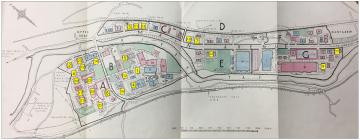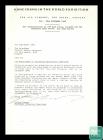Content can be downloaded for non-commercial purposes, such as for personal use or in educational resources.
For commercial purposes please contact the copyright holder directly.
Read more about the The Creative Archive Licence.
Description
This photograph shows the Isaac Samuel Hall which was built behind the synagogue. It was used for cheder (religious instruction) and social events, including a youth club.
Philip Kaye: "And in the back of that whole site, was the youth centre, and the youth centre contained downstairs the cheder rooms—the classrooms—and there was one, two three, there were four classrooms downstairs. There was a snooker room that belonged to the youth club upstairs, and as you walked in there was the toilets on the right-hand side, and then you used to walk up the stairs, and there was an office at the top of the stairs, before you walked into the coffee bar, and then after the coffee bar was the main hall where all the activities were held. I know it so well because, eventually, not only having attended the youth club, but I used to be the youth leader for quite a while when in my later teens. But unfortunately, their community is dwindling and diminishing, and we do not have those facilities these days.
… it was ‘78-’79. There was, every Sunday night there was an activity upstairs in the youth club, and my sisters used to go there when I was even younger, so if I was all of eight, nine, ten, eleven, they were in their teens and older teens. They used to go and mix. They used to have a mini-raffle, and the prize of the mini-raffle was actually a Mini car, and the Mini car was worth £500. And that was the prize, once a year. And they used it for raising money for whatever."
(From a JHASW oral history interview with Philip Kaye, 29 November 2018.)
Lionel Elton: "Yes, we met it behind, and we had on a Sunday, Sunday morning, Sunday afternoon, and Sunday evening. The little ones—my late wife Miriam in fact, she was in charge of the little ones, from about eight to twelve. And she had about forty kids, they did what you, to think she was a mother figure at the age of seventeen. Amazing woman she was. And I was in charge of the middle age, and then the elders, as we were called, we ran ourselves. So, at, at the back, I forget what the name of the place was, but there were school rooms downstairs where they taught religious instruction, and upstairs was a sort of hall with a little stage. And we had the children there in the morning, Miriam took them. I used to occasionally go. And then later in the early afternoon and early evening, would be the teenagers, and then we would be there in the evening. So, it was, it was, every Sunday. It was good. Very important to me."
(From a JHASW oral history interview with Lionel Elton, 30 October 2018.)
PW: "But they—the youth centre in Cardiff in Cathedral Road became a great place, because we used to have table-tennis upstairs there and I remember a lot of the guys playing in that and afterwards we used to sit down and play three card brag and whatever, and our parents all got a bit fed up with that so we had—they—later on they—I must have been about fifteen I suppose, fifteen years of age, and they decided we need—we should learn a proper card game, so we learned to play bridge, and we had a guy who was a Welsh international bridge player, a guy called Paul Spurway and he was an accountant in Cardiff—not a Jewish guy and he taught us to play with a couple of ols—we had Welsh international players as well, there was Ike Cotsen and Harold Bellman and one of the other Brownman brothers as well, and they—they taught us a lot about bridge and there were probably about twenty, twenty-five of use learnt to play, and we still in fact played for the rest of my days, because they taught us a lot, and a lot of the guys I still see and play bridge, and those who aren’t in London are in Cardiff, and they learnt there as well. So, it—it was a fantastic thing. We had dances there as well, you know, it was a great meeting place for—and the girls used to go, so we had all different stuff there."
(From a JHASW oral history interview with PW, 19 August 2018.)
Ralph Cantor: "In Cathedral Road, there was also a youth club called the Cardiff Jewish Youth Club. The funny thing about that, my brother helped to form that and at first they called it the Mecca Club until they realised the significance, [laughs], of the word Mecca — and they used to meet every Sunday, the Cardiff — and the thing about the C — as it came to be known as CJYS is they became a very successful table-tennis team, and they won shields , I got one in the garage, someone gave me a shield from the table-tennis and they had I think three teams and they were quite a successful table-tennis thing and of course that was good because they obviously played in Cardiff and districts, it was non — it wasn’t — it was non-Jewish, we never had any antisemitism that I was aware of in the table-tennis and the funny thing about — I always laugh actually 'cos I — I quite enjoy a writer called Howard Jacobson, and he has written a book called, “The Mighty Walzer”, which is almost autobiographical of him growing up, and he was a table-tennis player and he had the same problems as we had in that when you’ve played home, you have an interval when you have coffee and biscuits, and the biscuits had to be Kosher, [laughs]..."
(From a JHASW oral history interview with Ralph Cantor, 20 January 2019.)
Stephen Hamilton: "… at the back of the synagogue was the youth centre, which attracted most of the Jewish community, the youths, shall we say, even though it was in the lesser —not in the necessarily most popular side of town but yeah. In it — I — in its heyday was probably before we arrived in Cardiff, but it still carried on for a few years after 1964 when we came here.
I can remember belonging to the local Jewish boy cubs and we used to meet up there every week, but yeah, they used to put on the — we had youth leaders who would put on various events throughout the year and — but sadly, you know, with the decline in population and other interests occurring, it eventually had to close.
Cheder. We were taught initially when we came to Cardiff by a layperson called Moses Samuel, lovely, lovely guy, and in those days in Cathedral Road, we had a taxi who would come and collect us to ensure we went. He took the younger of the classes and then graduated to Reverend Fine’s class up until Bar Mitzvah age and then after Bar Mitzvah age, they — there was a class run by Reverend Grey, Reverend Gershon Grey, but unfortunately after a while, having achieved Bar Mitzvah, one’s inclination to carry on with Jewish education subsided somewhat and didn’t last for too long thereafter."
(From a JHASW oral history interview with Stephen Hamilton, 9 November 2018.)
CW: "...I think that was the first team that we entered the Cardiff District Table Tennis League. We used to play in the Cathedral Road Synagogue, a small hall there which was quite dilapidated, missing floorboards and we had a rickety old table, but nevertheless, we became good enough to get into the Cardiffian District League. Eventually, we got several teams into the league and we ended up in the Premier Division, probably eight or nine years later. We did have a fantastic sponsor, Mr. Jack Bernstein, who sponsored us in the close season to be coached and we were coached at that time by Walt Sweetland, who was the Welsh number one table tennis-player and that went on until I left Cardiff really."
(From a JHASW oral history interview with CW, 3 June 2018.)
Cathedral Road Synagogue opened in 1897.
This photograph is part of a collection taken by Alan Schwartz prior to the closure of the synagogue in 1989. It is reproduced with the permission of his brother Anthony Schwartz.
Depository: Glamorgan Archives.






Do you have information to add to this item? Please leave a comment
Comments (0)
You must be logged in to leave a comment